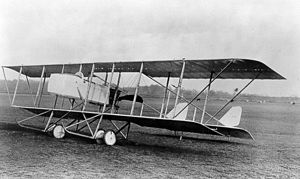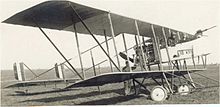Farman MF.11
Farman MF.11
Jump to navigation
Jump to search
| MF.11 | |
|---|---|
 | |
| Role | Reconnaissance / Light Bomber |
| Manufacturer | Farman Aviation Works |
| Designer | Maurice Farman |
| First flight | 1913 |
| Introduction | May 1914 |
| Primary users | French Air Force Royal Flying Corps |
The Maurice Farman MF.11 Shorthorn is a French aircraft developed before World War I by the Farman Aviation Works. It was used as a reconnaissance and light bomber during the early part of World War I, later being relegated to training duties.
The Maurice Farman Shorthorn was the aircraft in which Biggles, Capt W.E. Johns' fictional character, first took to the air in "Biggles Learns To Fly".
Contents
1 Design and development
2 Operational history
3 Operators
4 Survivors
5 Specifications (MF.11)
6 See also
7 References
8 External links
Design and development[edit]
A pusher configuration unequal-span biplane like the earlier Farman MF.7, the MF.11 differed in lacking the forward-mounted elevator, the replacement of the biplane horizontal tail surfaces with a single surface with a pair of rudders mounted above it, and the mounting of the nacelle containing crew and engine in the gap between the two wings. The aircraft was also fitted with a machine gun for the observer, whose position was changed from the rear seat to the front in order to give a clear field of fire.
Its name derived from that of the MF.7 Longhorn, as it lacked the characteristic front-mounted elevator and elongated skids of its predecessor.
Operational history[edit]

Farman F11-A2 of the Belgian Air Force displayed in the Brussels War Museum in July 1965

The remains of the first aircraft shot down by Robert Ritter von Greim 10 October 1915 the Pilot and observer of Escadrille MF 63 were killed[1]
On 6 September 1914 the first air-sea battle in history took place when a Japanese Farman MF.11 aircraft launched by the seaplane carrier Wakamiya unsuccessfully attacked SMS Kaiserin Elisabeth with bombs.[2]
The MF.11 served in both the British and French air services on the Western Front in the early stages of the war. As a light bomber it flew the first bombing raid of the war when on 21 December 1914 an MF.11 of the Royal Naval Air Service attacked German artillery positions around Ostend, Belgium.
The MF.11 was withdrawn from front-line service on the Western Front in 1915, but continued to be used by the French in Macedonia and the Middle East, while the British also used it in the Dardanelles, and Africa. The Australian Flying Corps (AFC), provided with the MF.11 by the British Indian Army, operated it during the Mesopotamian campaign of 1915–16.
Italy's Società Italiana Aviazione, a Fiat company, licence-built a number of MF.11s under the designation SIA 5 from early 1915, fitted with a fixed forward machine gun and a 74.5 kW (100 hp) Fiat A.10 engine.[3]
In 1916, the AFC also bought some MF.11s for training purposes.

Reconnaissance version of the MF.11 with camera detail

Italian air force MF.11
Operators[edit]
 Australia
Australia
Australian Flying Corps
No. 5 (Training) Squadron AFC in United Kingdom- Mesopotamian Half Flight
- Central Flying School AFC at Point Cook, Victoria
 Belgium
Belgium
- Belgian Air Force
 France
France
- French Air Force
 Kingdom of Italy
Kingdom of Italy
- Corpo Aeronautico Militare
 Greece
Greece
- Hellenic Air Force
 Japan
Japan
- Imperial Japanese Army Air Service
 Norway
Norway
- Royal Norwegian Air Force
 Portugal
Portugal
- Portuguese Air Force
 Romania
Romania
- Royal Romanian Air Force
 Russia
Russia
- Imperial Russian Air Force
 Saudi Arabia
Saudi Arabia
Royal Saudi Air Force - Two Farman MF.11s were obtained from Italy in 1921.
 Serbia
Serbia
- Serbian Air Force
 Spain
Spain
- Spanish Air Force
 Switzerland
Switzerland
- Swiss Air Force
 Ukraine
Ukraine
Ukrainian Air Force - One aircraft only.
 United Kingdom
United Kingdom
Royal Flying Corps- No. 2 Squadron RFC
- No. 3 Squadron RFC
- No. 4 Squadron RFC
- No. 9 Squadron RFC
- No. 14 Squadron RFC
- No. 16 Squadron RFC
- No. 19 Squadron RFC
- No. 23 Squadron RFC
- No. 24 Squadron RFC
- No. 25 Squadron RFC
- No. 29 Squadron RFC
- No. 30 Squadron RFC
- No. 65 Squadron RFC
- Royal Naval Air Service
Survivors[edit]
- The Canada Aviation Museum has an MF.11 manufactured by Airco for the Royal Flying Corps and sent to Australia in 1916.
- Farman F.11A-2, Royal Army and Military History Museum, Brussels, Belgium.
- Farman MF.11 Shorthorn (#CFS-15), RAAF Museum at Point Cook, Victoria, Australia.
Specifications (MF.11)[edit]
Data from Encyclopedia of Military Aircraft[4]
General characteristics
Crew: Two (pilot & observer/gunner)
Length: 9.45 m (31 ft 0 in)
Wingspan: 16.15 m (53 ft 0 in)
Height: 3.18 m (10 ft 5 in)
Wing area: 57.00 m² (613 ft²)
Empty weight: 550 kg (1,210 lb)
Loaded weight: 928 kg (2,045 lb)
Powerplant: 1 × Renault 8-cylinder air-cooled inline engine, 75 kW (100 hp)
Performance
Maximum speed: 106 km/h (57 knots, 66 mph) at sea level
Service ceiling: 3,800 m (12,467 ft)
Endurance: 3.75 hours
Armament
Guns: 1 × 7.62 mm (0.30 in) machine gun
Bombs: 18 × 7.3 kg (16 lb) bombs
See also[edit]
Related development
- Farman MF.7
Related lists
- List of military aircraft of France
References[edit]
^ The Aerodrome Forum]
^ Donko, Wilhelm M.: „Österreichs Kriegsmarine in Fernost: Alle Fahrten von Schiffen der k.(u.)k. Kriegsmarine nach Ostasien, Australien und Ozeanien von 1820 bis 1914“ (epubli, Berlin, 2013) - Page 4, 156-162, 427.
^ Taylor, Michael J H. Jane's Encyclopedia of Aviation. pg 805. Portland House, 1989. .mw-parser-output cite.citationfont-style:inherit.mw-parser-output qquotes:"""""""'""'".mw-parser-output code.cs1-codecolor:inherit;background:inherit;border:inherit;padding:inherit.mw-parser-output .cs1-lock-free abackground:url("//upload.wikimedia.org/wikipedia/commons/thumb/6/65/Lock-green.svg/9px-Lock-green.svg.png")no-repeat;background-position:right .1em center.mw-parser-output .cs1-lock-limited a,.mw-parser-output .cs1-lock-registration abackground:url("//upload.wikimedia.org/wikipedia/commons/thumb/d/d6/Lock-gray-alt-2.svg/9px-Lock-gray-alt-2.svg.png")no-repeat;background-position:right .1em center.mw-parser-output .cs1-lock-subscription abackground:url("//upload.wikimedia.org/wikipedia/commons/thumb/a/aa/Lock-red-alt-2.svg/9px-Lock-red-alt-2.svg.png")no-repeat;background-position:right .1em center.mw-parser-output .cs1-subscription,.mw-parser-output .cs1-registrationcolor:#555.mw-parser-output .cs1-subscription span,.mw-parser-output .cs1-registration spanborder-bottom:1px dotted;cursor:help.mw-parser-output .cs1-hidden-errordisplay:none;font-size:100%.mw-parser-output .cs1-visible-errorfont-size:100%.mw-parser-output .cs1-subscription,.mw-parser-output .cs1-registration,.mw-parser-output .cs1-formatfont-size:95%.mw-parser-output .cs1-kern-left,.mw-parser-output .cs1-kern-wl-leftpadding-left:0.2em.mw-parser-output .cs1-kern-right,.mw-parser-output .cs1-kern-wl-rightpadding-right:0.2em
ISBN 0-517-69186-8
^ Jackson, Robert, The Encyclopedia of Military Aircraft, Paragon, 2002.
ISBN 0-7525-8130-9
External links[edit]
| Wikimedia Commons has media related to Farman MF.11. |
- Luftfahrtmuseum
- Canadian Aviation Museum
Categories:
- French military reconnaissance aircraft 1910–1919
- French bomber aircraft 1910–1919
- Single-engined pusher aircraft
- Biplanes
- Farman aircraft
- French military trainer aircraft 1910–1919
- Aircraft first flown in 1913
(window.RLQ=window.RLQ||).push(function()mw.config.set("wgPageParseReport":"limitreport":"cputime":"0.324","walltime":"0.524","ppvisitednodes":"value":2574,"limit":1000000,"ppgeneratednodes":"value":0,"limit":1500000,"postexpandincludesize":"value":30613,"limit":2097152,"templateargumentsize":"value":3827,"limit":2097152,"expansiondepth":"value":14,"limit":40,"expensivefunctioncount":"value":0,"limit":500,"unstrip-depth":"value":1,"limit":20,"unstrip-size":"value":4901,"limit":5000000,"entityaccesscount":"value":1,"limit":400,"timingprofile":["100.00% 402.673 1 -total"," 20.32% 81.834 16 Template:Flag"," 19.70% 79.335 1 Template:Reflist"," 17.75% 71.478 1 Template:Commons_category"," 17.47% 70.346 2 Template:ISBN"," 15.25% 61.398 1 Template:Commons"," 14.76% 59.424 1 Template:Sister_project"," 14.59% 58.737 1 Template:Infobox_Aircraft_Begin"," 13.99% 56.354 1 Template:Side_box"," 11.90% 47.916 2 Template:If_then_show"],"scribunto":"limitreport-timeusage":"value":"0.048","limit":"10.000","limitreport-memusage":"value":2745149,"limit":52428800,"cachereport":"origin":"mw1337","timestamp":"20190114192150","ttl":1900800,"transientcontent":false);mw.config.set("wgBackendResponseTime":93,"wgHostname":"mw1330"););

